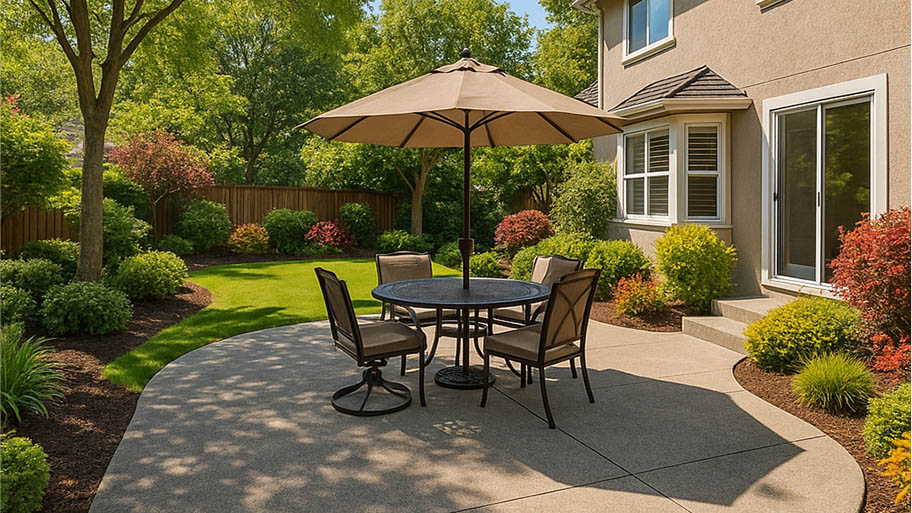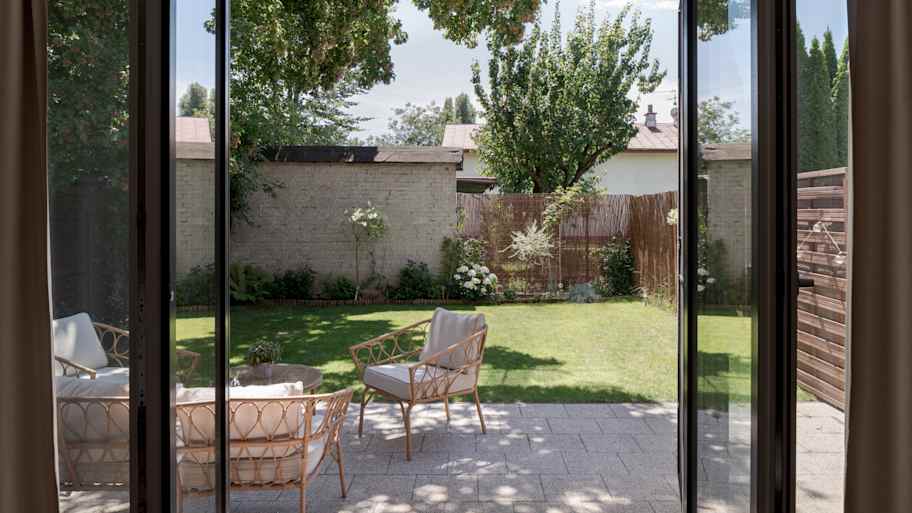
A deck skirt can improve the form and function of a deck. Find out what it could cost to install deck skirting in your backyard with this guide.
Patio repair costs an average of $1,599, and most projects fall between $726 and $2,485. Your total will depend on the type of repairs and extent of the damage, so contact a pro for an accurate estimate.


Patio repair costs range widely from small DIY fixes under $100 to professional repairs costing $80 to $6,000, depending on patio size, material, and damage severity.
Patio material heavily impacts pricing, with repairs costing $5 to $8 per square foot for asphalt, $5 to $20 for concrete, and up to $30 per square foot for pavers.
Repair type influences cost significantly, with resealing starting at $1.35 to $2.50 per square foot and resurfacing at $3 to $10 per square foot.
Labor accounts for 50% to 90% of total repair costs, with pros typically charging $35 to $110 per hour, depending on the complexity and whether masonry expertise is required.
Your patio repair costs will depend on a few key factors, so you’ll need to consider all of the following to get an accurate estimate for your project.
The type of patio you have is the most important cost factor to consider when pricing out your repair costs. Standard asphalt or concrete patios can cost as little as $5 per square foot for repairs, while paver patio repairs can climb as high as $30 per square foot to repair, as they require all new materials in many cases.
| Patio Material | Repair Cost (Sq. Ft.) |
|---|---|
| Asphalt | $5–$8 |
| Brick | $11–$14 |
| Concrete | $5–$20 |
| Natural stone | $14–$17 |
| Paver | $7–$30 |
| Stamped concrete | $6–$20 |
| Tile | $4–$20 |
Patio repair costs also depend largely on the type of repair you need. Cosmetic repairs to seal a hairline crack in a concrete patio will cost under $100 in most cases, but mudjacking to raise a sunken section of a concrete patio can cost $800 or more. You may need to consider multiple types of patio repairs if your outdoor area is in poor condition, in which case it’s best to get a professional estimate to see what your total will be.
| Type of Repair | Cost (Sq. Ft.) |
|---|---|
| Mudjacking | $3–$8 |
| Replacement | $5–$35 |
| Resealing | $1.35–$2.50 |
| Resurfacing | $3–$10 |
As you can see from the pricing structures above, most patio repair companies will charge based on how many square feet of patio you need to be repaired. As such, the size of the damaged area will also have a major impact on your repair costs. You can use the table below to get an idea of what your average repair costs will be for things like spalling, crumbling, and sinking sections of patio.
| Damaged Area (Sq. Ft.) | Average Repair Cost | Cost Range |
|---|---|---|
| 10 | $100 | $80–300 |
| 20 | $200 | $80–$600 |
| 50 | $500 | $200–$1,500 |
| 100 | $1,000 | $400–$3,000 |
| 200 | $2,000 | $800–$6,000 |
Of course, the extent of the damage to your patio will affect the cost of repair. Surface cleaning and crack sealing are some of the simplest repairs you could need and will cost you between $80 and $400. Instability from poor drainage or expansive soil beneath the patio could necessitate a total patio replacement, which costs an average of $4,000 and as much as $14,000, depending on size and materials. You may also need to install a drainage system under the material, which can push the cost of a new patio even higher.
The location of your patio and its accessibility can affect repair costs, especially if your type of repair requires heavy machinery. For example, your pricing could increase significantly if your professionals need to use manual tools to mix concrete for resurfacing because a dangerous slope or tight section of trees prevents access for a mixer.
Labor accounts for between 50% and 90% of your patio repair costs, depending on the type of repair and the extent of the damage. That means labor costs range from $350 up to $2,250 for most repair jobs, and the average cost for labor is $1,120. General concrete companies charge as little as $35 an hour for labor, while professional masons can charge up to $110 per hour for more complex jobs.

A good way to figure out if you should repair or replace your patio is to consider the cost of each, as well as your patio’s age.
First, get estimates from professionals for repairs and a full replacement. If the patio repair cost is more than 50% of the patio replacement cost, a full replacement of your patio is going to be a better value over time. In many cases, a replacement will be a better option if the repair involves mudjacking and resurfacing, while a repair is best if you’re just dealing with surface cracks and some minor spalling.
Second, consider the age of your patio. A full replacement is going to provide more value if your patio is beyond half of its lifespan and requires major repairs. For a concrete patio with a standard lifespan of 30 years, consider replacing it if you need repairs after the 15-year mark.
Hiring a local patio repair pro costs more upfront, but you benefit from accurate assessment, proper repair techniques, and long-lasting results. Pros bring the right tools, materials, and experience to fix issues such as cracks, sinking pavers, uneven slabs, or drainage problems—helping prevent recurring damage and additional repair costs.
Repairing a patio involves addressing surface damage, foundation issues, and drainage conditions that affect long-term stability. Here are some of the top reasons to work with a pro:
Pros know how to identify the root cause of damage—whether it’s settling soil, poor drainage, shifting pavers, or deteriorating concrete—ensuring the repair lasts.
They use the correct repair methods, such as leveling sunken areas, replacing broken pavers, resurfacing concrete, or improving drainage to prevent future problems.
Hiring a pro reduces the risk of causing further damage, such as cracking adjacent slabs or creating unstable areas that can lead to tripping hazards.
Many contractors can bundle services like sealing, staining, installing edging, or adding joint sand to restore your patio’s appearance and structural integrity.
If you want to take on some tasks yourself, here are a few DIY steps that can help reduce time and labor costs:
Clear furniture, planters, and décor from the patio area before the contractor arrives to give them easy access to the repair site.
Clean the patio surface and remove debris to help the professional clearly assess cracks, sinking areas, or damaged pavers.
Document any changes you’ve noticed over time—such as pooling water, widening cracks, or uneven spots—to help the pro identify underlying issues quickly.
Patio repair costs can climb as high as $5,000, so you may want to consider the following tips to save money up front and over time.
Consider a replacement based on patio age: Replacing your patio will almost always be more expensive than repairing, but if the material has reached half of its lifespan, you could save on repeat repair costs down the road by splurging on a replacement instead.
Handle cosmetic repairs yourself: Surface cracks on concrete patios, single pavers that need replacement, and even heavy soiling and staining are all jobs you can DIY. If you have some time to spare, you could save most of the repair costs on labor.
Treat the underlying problem: Some severe problems, like a sinking patio or structural cracks, will only continue to return if you don’t treat the underlying issue up front. You may spend more now on installing a drainage system around your patio, but it could pay for itself by allowing you to get the problem fixed once and for all.
Get multiple estimates: Finally, get at least three estimates from different patio repair companies to compare. Professionals all charge different rates, so shop around for the best value.
Share what material your patio is made of (concrete, pavers, brick, or stone) so the pro can bring the right tools and repair products.
Describe any issues you’ve noticed—such as cracks, sinking areas, loose pavers, or drainage problems—to help them determine the repair scope.
Ask whether you need to prep the area beforehand, like moving furniture, planters, or outdoor décor.
Confirm whether unexpected costs could arise from hidden problems like soil erosion, root damage, or underlying drainage issues.
If you're considering upgrades—such as sealing, re-leveling the entire surface, or adding edging—ask whether it’s efficient to tackle them during the repair.
Home is the most important place on earth, which is why Angi has helped more than 150 million homeowners transform their houses into homes they adore. To help homeowners with their next project, Angi provides readers with the most accurate cost data and upholds strict editorial standards. We’ve surveyed thousands of real Angi customers about their project costs to develop the pricing data you see, so you can make the best decisions for you and your home. We pair this data with research from reputable sources, including the U.S. Bureau of Labor Statistics, academic journals, market studies, and interviews with industry experts—all to ensure our prices reflect real-world projects.
Want to help us improve our cost data? Send us a recent project quote to [email protected]. Quotes and personal information will not be shared publicly.
From average costs to expert advice, get all the answers you need to get your job done.

A deck skirt can improve the form and function of a deck. Find out what it could cost to install deck skirting in your backyard with this guide.

Learn the cost of a metal awning for your home. Discover the essentials of installation, materials, and labor, and explore ways to save on your project.

A concrete patio adds valuable outdoor living space to your home. Learn how much a concrete patio costs and which factors affect the project price.

Upgrade your home value and yard enjoyment by installing a patio. Learn about patio sizes and how to decide on dimensions for your project.

Wondering who builds decks? Here’s who to hire and what you need to consider before starting a deck-building project.

Sealing a deck can protect it from moisture and rot. But will liquid rubber cover between deck boards? Learn all about liquid rubber for decks here.